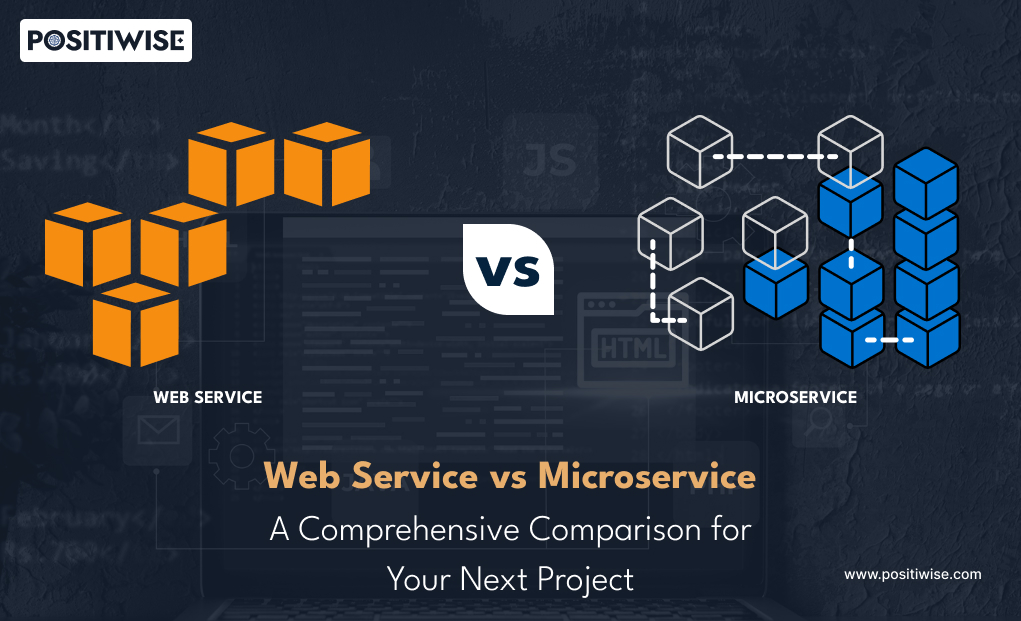Quick Overview:
With the evolving tech development marketplace, technological advancements have redefined the web application development arena. In the past, monolithic architecture was sufficient to build a performant web app that performed well in the market. But, with changing needs and increasing complexity of the applications, the service-oriented architectures, microservices, and web services have gained a place for themselves. This blog post will thoroughly compare web service vs microservice to help you better understand the ideal choice for your next web app development project.
Introduction
Microservices vs. web service, both at a glance, seem to be two sides of the same coin. However, the reality turns out to be different. Microservices refer to building applications from more minor services or microservices that work hand-in-hand. On the other hand, web services, in simple terms, are programmable components that interact with one another using the internet as a channel for interaction. Both tech architectures share similarities; they fulfill different purposes or implementations.
What are Web Services?
Web Services refer to just one of the multiple tech stacks that can offer services over “web” or HTTP. In simple words, web services are a way to showcase the functionality of an application to other apps without the involvement of a user interface. It is a service that exposes API over HTTP.
Web services enable web apps developed on diverse technologies to interact with each other via common formalities like XML, Jason, or others. Web services are not confined to a single operating system, programming language, or user device software platforms.
Web services are neither associated with frontend development nor are connected to any development languages or user devices’ software platforms. It makes consolidating different web services into a single one possible if written in other languages and for separate operating systems similar to microservices.
Benefits of Web Services
Web Services offer several benefits that can be beneficial for the following web app development project. Let us have a look at a few of such benefits:
- Interoperability: Web services are interoperable between diverse web services by regularizing the communication process, making them tech-independent. Organizations these days develop separate web services in various programming languages and host them on different infrastructures, and app platforms are also independent.
- Economical and Fast Communication: Protocols such as HTTP, SOAP, and HTTPS are cost-effective compared to other solutions, such as business-to-business communication, as communication amid web services is faster and more economical in cost.
- Re-Usability: The web services offer precise functionalities ranging from generic information extraction to complex computations. Organizations can reuse the specific parts of these web apps based on their requirements and add more value to their services and products.
- Simplified Communication: As in Web Services, the representation and data transfer are handled using XML. Thus, it requires minimal effort for communication, making it simplified for all.
What are Microservices?
As the name suggests, microservices refers to a software architecture that can be used alongside web services. It includes compartmentalizing large software applications into decoupled or independent modules where microservices run unique processes and communicate via APIs. As every microservice runs as an individual entity, you can build, deploy, and scale microservices independent of other services running alongside them and of the application as a whole.
The microservices architecture emerged as a response to the traditional monolithic architecture for creating web apps. In traditional architecture, there used to be a single code base for everything the app did, and even a minor edit was needed to deploy the entire application.
Benefits of Microservices
Microservices are lightweight and flexible, which contributes to your web app development. The most prominent benefits are as follows:
- Deployment Speed: Microservices architecture allows for CI/CD of large and complex apps, reducing the market time.
- Resilience: As in microservice, each service is compartmentalized. Therefore, an issue or failure of one service doesn’t affect the overall application’s functioning.
- Maintenance Ease: The autonomous nature of each service in microservices enables easy maintenance, as updating or editing the code of one service doesn’t require a change in the whole codebase.
- Modularity: The system is modular, with each service handling separate business functionality. The autonomous teams can easily make changes and maintain and develop each service separately.
- Scalability: The microservice offers on-demand scalability, meaning each service can handle increased load without hampering the performance of other services or the app.
- Portability: Microservices provide better portability across platforms or containers as they can be easily deployed on containers.
Web Service vs Microservice – Comparison Table
A web service is a software module that performs specific functions. In contrast, a microservice is an architectural style that structures an application as a collection of services. Below is a tabular representation of the circumferential comparison between microservice and web service.
| Parameter | Microservices | Web Services |
|---|---|---|
| Brief Explanation | A software architecture that can be implemented with web service | A technology for providing services. |
| Services | Self-contained app that offers unique services to larger apps | Used as a strategy to improve the service availability in the app |
| Integration | Horizontal in approach and nature | Vertical in nature, i.e., compared to provider-consumer communication |
| Data Sharing | Limited in sharing by bounded context | Make it easy to share component data |
| Function | It can be implemented using different technologies and can also be deployed independently | Allow creating apps by using XML messages |
| Complexity | More complex and compact | It is simpler compared to microservices |
| Scalability | Easily scalable as each service can be scaled independently | Require scaling the entire system rather than specific components |
| Flexibility | Highly flexible | Comparatively less flexible |
Web Service vs Microservice – In-Depth Comparison
Now that we have seen the comparison between Microservice and Web services let us move ahead with the detailed comparison to help you decide which is your go-to option for your upcoming project.
Architecture
Web services are a modular services-oriented application architecture model where the applications that comprise the architecture connect via web services. It is a lightweight architecture that identifies the needed elements of a web service network and offers interoperable communication between systems.
However, microservices refer to a modular service-oriented architecture comprised of loosely connected, independent-running services or smaller modules for better understanding, implementation, and further software development. These microservices usually offer APIs, allowing the other microservices and applications to integrate.
Scope
As the name suggests, microservices generally have a smaller scope as each service has a prime focus on a specific individual functionality. Considering the Facebook messenger platform with a dedicated microservice for file attachment management. Use Facebook’s Attachment Upload API to access this capability.
Web services offer a single or a slew of services via a single app. This authorizes the web services architecture to organize access to multiple app services. Considering an eCommerce service, one web service may offer ordering and payment services to the end customers while the other could provide inventory management services to non-customers. These are all accessible via different web services but are a part of the same application. Therefore, web services can help manage and control access to the multiple services that constitute an application.
Pluggability
Microservices are like special building blocks that can easily connect using little connectors. They are flexible; you can add, remove, or change them without messing up the whole structure.
The APIs responsible for linking the microservice offer additional versatility since they handle both HTTP and HTTPS and can build connections across different message formats and protocols.
Web services are a bit more limited and do not support HTTPS, and the components that communicate with them must use the same message format and protocol. The iPaaS, like DreamFactory, can efficiently resolve a web service connection’s message format and protocol constraints.
Function
Web services help enhance the integration of applications more than before their existence. Ti helps reduce the expense of eCommerce transactions by offering direct interaction between applications using internet standards and protocols.
Microservices are self-sufficient groups of small applications developed to solve problems for larger systems. This allows for easier system development by breaking it into manageable modules that can be quickly created, tested, and deployed separately.
Structure
Microservices, in simple, is an architectural style built for business capabilities. Simultaneously, it can be integrated into a web service. However, the microservices can be a stand-alone service or a function with its database and can be easily implemented and deployed independently of other services.
On a different note, web service is provided from one application to another through the World Wide Web. As an API representation via HTTP, it is an abstraction layer that separates between a platform and the precise programming details of how the app code is called to function.
Size
Web services follow a conventional service-oriented approach or SOA and are generally larger entities. The web services include multiple functionalities and are accessed over the web using protocols such as SOAP or REST.
Microservices are smaller, highly modular entities focusing on a specific business capability and communicating via lightweight protocols such as HTTP or messaging queues. This modular design approach facilitates more effortless scalability, flexibility, and independent deployment of individual services.
Therefore, microservices are more agile and adaptable to building software systems than web services’ more monolithic nature.
Complexity
Both services have their share of complexities; however, on an individual level, microservices are typically more complex in terms of architecture because of their distributed approach. The reason behind this complexity is the need to manage all the independent parts.
Web services are comparatively less complex because of their standardized approach and centralized management. However, they are not ideally simple and possess their fair share of complexity when adhering to specific standards.
Get Professional Software Development Services for Your Project
Seeking high-quality software development solutions? Our proficient team of software developers is prepared to transform your concepts into reality.
Microservices or Web Services: The Better Choice For Your Next Project?
When choosing between web services and microservices for your next project, it is crucial to understand their specific advantages. On the one hand, web services offer independence from monolithic systems without the need for additional server expenses. They help streamline application development and future updates, making modifications and alterations easier.
Microservices on the other front, provide exceptional flexibility that allows for scalable functionality and better system stability. However, they come with increased development and maintenance overhead. Microservices enable your applications to grow and adapt to changing needs and demands, but this comes with the cost of increased complexity.
You can opt for either of the two that ideally align with your project’s needs, complexity, scalability requirements, and long-term maintenance concerns. You can make a final call that best fits your web app development based on the in-depth evaluation.
Conclusion
With this, we can finally conclude that Web Service vs Microservices is not a race between the two but is a practical approach to making a final call and choosing the ideal one for your next project based on your needs and requirements.
However, if you still find it challenging to make a call between the two, you can contact market experts like Positiwise to help you gain insight and make a final call that aligns with your overall project goals and requirements.
FAQs
Is it possible to use microservices and web services together?
Yes, you can use web services and microservices together and apply microservices using the web services. After that, use web services to communicate between microservices.
How do microservices and web services address security concerns?
To address the security concerns, ensure microservices are secure with HTTPS, encryption, and the authentication token. The timely audits offer added security. Similarly, you can protect your web services with encryption authentication and authorization to counter vulnerabilities.
Microservice or Web Service, which offers better flexibility and agility?
Microservices present a more flexible and agile approach compared to web services. Web services are simple to implement and can be less flexible for quick changes or adapting to modified system requirements. Contrary to this, microservices offer each service to develop, deploy, and scale independently, leading to better flexibility and agility.
Do microservices need a web server?
Generally, you don’t need a dedicated web server to serve a microservice. Still, depending on your deployment architecture and technical needs, you might need one as a load balancer if you do not use a dedicated load balancer such as haproxy.
Is web service an interface?
A web service is a software system that supports interoperable machine-to-machine interaction over a network. It has an interface described in a machine-processable format, especially WSDL.
Expert in Marketing Strategy and Brand Recognition
Jemin Desai is Chief Marketing Officer at Positiwise Software Pvt Ltd, he is responsible for creating and accelerating the company’s marketing strategy and brand recognition across the globe. He has more than 20 years of experience in senior marketing roles at the Inc. 5000 Fastest-Growing Private Companies.






